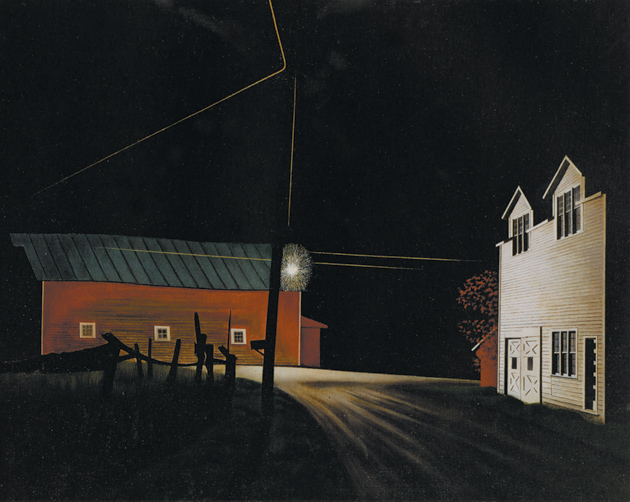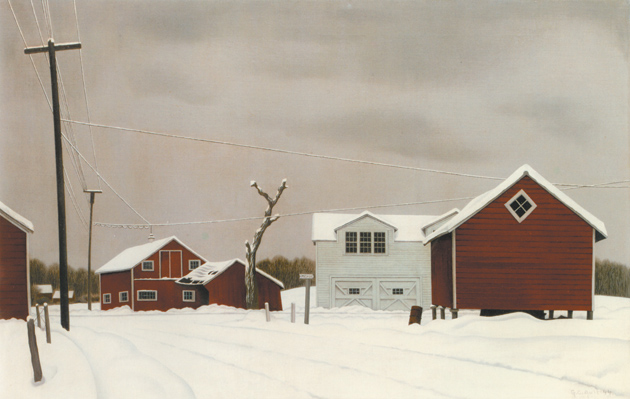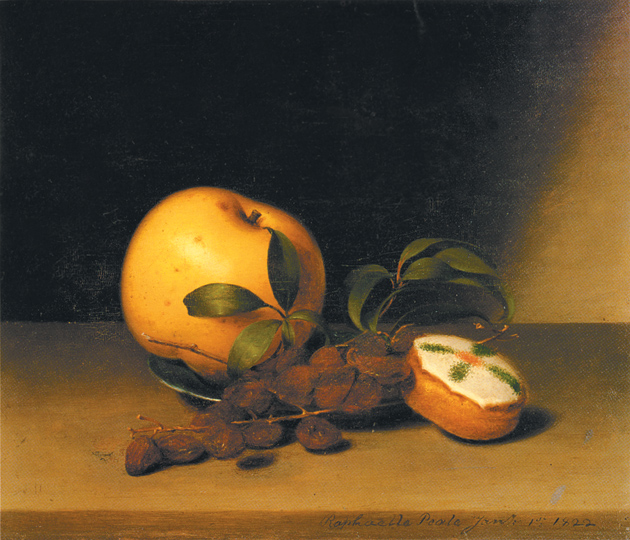The Smithsonian American Art Museum’s exhibition “To Make a World: George Ault and 1940s America” is on the face of it a welcome and overdue event. It presents as a kind of hero and dominant presence a painter who has been a slightly peripheral figure in our art. On a first, quick look, one can see why. With his views of New York City buildings, rooftops, and streets when no one is around, and his scenes of barns and fields set in the Woodstock area, in the Catskills, where he lived in the last decade of his life, George Ault (1891–1948) can seem to be merely one more artist of the American scene during the period from the 1920s through the 1940s. The streamlined, geometric clarity he gives to his images of city buildings dovetails with the work of Charles Sheeler and Georgia O’Keeffe, among others, and, imbuing his pictures of places, whether in a city or the country, with a note of stoic isolation, he recalls even more Edward Hopper.
For his admirers, though, Ault is a vital artist because of his particular high-strung, all-or-nothing quest to get his forms and colors as tautly aligned as possible. Looking at his small canvases, where paint has been applied with a spartan economy—and where the slight awkwardness of the forms appealingly reminds us of folk art, which Ault admired—we find, moreover, an artist whose feeling for light is unlike anybody else’s. Hopper can make sunlight on a wall appear warm yet elegiac, a reminder of time and time’s passing. Ault is a master of a sunless and unwarming, yet sometimes slyly dramatic, light. In some of his Catskill landscapes he renders the bone-chilling gray-and-white light of a winter’s day as convincingly as any artist has.
His richest theme is the world at night. He can wittily capture the confusion when, in the evening, electric lighting inside a room becomes part of what we see when we look out the window. He makes a line of lights on a nighttime city street, unattached to any source of power, into a row of ping-pong balls floating in air. In his most mysterious and extraordinary works—four canvases of Russell’s Corners, a crossroads with some barns and a single hanging light in Woodstock—Ault does justice to that moment we have all experienced at night (and surprisingly few artists have shown) when overhead power lines, reflecting light from somewhere, become what might be called sky drawings.
Made between 1943 and 1948—and all, thankfully, in the Smithsonian’s exhibition—the Russell’s Corners paint- ings present a black nighttime setting, with no one around, touched here and there with areas of red and white (for the barns and light). Each painting shows the Corners from a different vantage point, and as Ault returned to the theme over the years he eliminated more of the details, so that the last painting is primarily black. Yet no one picture feels finer or deeper than the others. They are in part about darkness but they aren’t emotionally “dark.” They express, rather, the wonder of there being this shifting drama of piercing light and enveloping obscurity happening in the middle of nowhere, without anyone’s having quite planned it. If he had made no other works Ault would still be a remarkable figure.
The Smithsonian’s catalog represents the first time that the four Russell’s Corners pictures have been reproduced in color in one publication. Another first is the exhibition’s inclusion of Daylight at Russell’s Corners, a perfectly realized snow scene from 1944 that, not in the artist’s only other museum shows (organized by the Whitney in 1973 and 1988), will be news to veteran Ault-watchers. Presenting a startlingly white Russell’s Corners, it forms an invaluable companion to the nighttime versions (see illustration on page 88). But what the exhibition as a whole, and its catalog, do for George Ault is strangely (one might say inventively) muddled.
“To Make a World” brings together nearly twenty works by Ault with a picture or two each by twenty-two other artists. A few of them—Hopper, Sheeler, Rockwell Kent, Andrew Wyeth—are well known, but the others will probably draw a blank stare from even specialists in the period. Paul Sample, Dede Plummer, Veronica Helfensteller, Raphael Gleitsmann, Kelly Fearing, Bror Utter, and John Rogers Cox are some of them, and the show includes as well a blown-up still from the 1945 Joan Crawford movie Mildred Pierce, production design drawings for the film, and photographs (by unknown photographers) of young men and women from Woodstock in their armed forces uniforms. These photos and the one or two paintings that include servicemen remind us that a war was going on for part of the decade, and the anxieties of the war and its later-Forties aftermath are what the exhibition, as the Smithsonian puts it, is about.
Advertisement
The description of the show on the jacket flap of its catalog says that “uncertainty and despair” and “melancholy and separation” are threaded through the period. The images, however, don’t suggest an era’s “despair.” Ault’s pictures, when not of Catskill barns or fields, present his rare (and strained) attempts to paint the nude or concoct a surrealistic dream landscape. Hopper’s painting is a city railroad scene. Wyeth presents a country auction. Other pictures give us kite-flying kids, or ramshackle houses on a curvy road—or a bridge to a city at twilight, or someone waiting at a railroad station in a winter morning’s darkness. The still from Mildred Pierce bespeaks at most an upcoming dilemma for Joan Crawford, not for the United States.
The uncertainty and melancholy that pervade the exhibition derive, rather, from the bland, humdrum, and random nature of so much of the work on display. In principle it is intriguing to encounter the work of artists one has never heard of, and it is possible that some of these unfamiliar artists deserve a further look. The bright and blindingly realistic oil paintings of midwestern fields by John Rogers Cox at least suggest someone attempting a personal, edgy style. But the pictures by Paul Sample, Kelly Fearing, and the rest give us little more than a variety of serviceable, magazinish representational manners.
The Smithsonian’s show makes a kind of metaphorical and psychological sense, however, in the pages of its catalog, which has been written by Alexander Nemerov, who also organized the exhibition. He tells us that, in his initial plans for it, Ault was going to be merely one of many artists. But as he immersed himself in the work and life of the painter, he found that Ault spoke more profoundly of the underlying anxieties of the 1940s than did any other artist. Many of the pictures Nemerov gathered, it turns out, are foils to Ault’s images or his thinking. Edward Biberman’s painting from around 1945 of a strike scene at Warner Brothers in Hollywood is here because, while it shows a man with his back to us, this figure has little of the sense, which Ault presumably conveys in the 1945 picture of his wife with her back to us, of someone at an “existential standstill.” Dede Plummer’s 1944 New Haven Green, a rather gawky image of a crowded urban center, is here because in the same year the reclusive Ault talked about how much he disliked living in cities.
Except for Edward Hopper, seemingly every artist Ault is compared with comes up short. Charles Sheeler’s painting of the Amoskeag Mills in New Hampshire, from 1948, is devoid of people and, we read, emotionally “empty,” whereas Ault’s 1948 August Night at Russell’s Corners, while also devoid of people, somehow suggests a haunted locale. But what traction does Ault get from being compared in this way? When one of his paintings showing a grimly taut relationship between a telephone pole and a cloud from 1944 is described as more complex in feeling than a 1944 Bror Utter painting—where the telephone poles and clouds barely engage us one way or another—the victory is weightless. The terms in which Ault is being appreciated are those of illustrational art. He is being sold, essentially, as a more complex illustrator than the other, lesser illustrators. Marsden Hartley and Alfred Stieglitz were every bit as inspired by clouds as Ault. Why isn’t he being compared with them?
An art historian in his forties who is now the Vincent Scully Professor of the History of Art at Yale, Alexander Nemerov is in some ways a formidable figure. Even if you find his approach diffuse and impalpable (as I do), you are encountering a writer who is appraising the past in a new way and is willing to go out on a limb for underappreciated figures. His books include studies of the western artist Frederic Remington, the early-nineteenth-century Philadelphia still-life painter Raphaelle Peale, and the 1940s movie producer Val Lewton, whose credits include Cat People and The Curse of the Cat People. As set forth at least in the writing of his that I have read—his text for “To Make a World” and his study of Raphaelle Peale*—Nemerov’s concern is less the history of art than the way certain artists indirectly express, or indirectly form a criticism of, the wider social moment they come out of. Yet he also looks closely at artworks, and he builds his arguments by drawing large and symbolic conclusions from the literal content of the object before him.
Advertisement
When, for example, he is describing the power lines in the Russell’s Corners paintings, which Ault presents as so many unconnected bright streaks in the dark sky, Nemerov jumps to the issue of communication, which is implied by telephone poles. Because Ault shows fragments of lines, Nemerov decides that the painter’s underlying message is that full communication between people is impossible. Nemerov believes that this point of view is part of what makes Ault more truly attuned to the bleak spirit of the war years than, say, Norman Rockwell (who is in the catalog but not the show). Rockwell supposedly indicates in a couple of works from the same moment—magazine pictures that amusingly present the way information travels from person to person—that people truly can “communicate.”
Nemerov’s interpretation is probably right psychologically. In our chief source of information about Ault, the published (and unpublished) writings of his second wife, Louise Ault, he comes across as a prickly, hounded, and relatively friendless person. Louise’s Artist in Woodstock (1978) is a tender, and rather painful, account of an implacable man and artist who was wary of any art dealer who expected him to produce a “line” of pictures and severed his ties to the New York gallery world. He refused to take on any outside work that would interfere with his painting, and so, after moving to Woodstock in 1937, he and Louise lived in rented little houses without electricity or running water, surviving on the odd sale of a picture and on the trickle of money she brought in from her part-time journalism. Yet we have no knowledge that Ault was thinking about communication with his power lines. There is no evidence that, in a painting of a gushing waterfall, to take another of Nemerov’s many surmises, he was possibly expressing “tears about his own life.”
Reading Nemerov is a little dizzying. He makes a flowing stream out of historical facts, scholarly opinions, and his own suppositions. He mixes together intimate biographical details about his given subject, quotes from newspapers and other documents of the era he is looking at, references to art historians and theorists, what he believes is corroborating input from novels, poetry, or movies, and interpretations, which can get fairly heady, of details like clouds or waterfalls or, in a Raphaelle Peale still life, the appearance of a cut- open watermelon. (Might his urge to see links between seemingly unconnected things stem from awarenesses he had being part of a family where his father was the poet Howard Nemerov and his aunt was the photographer Diane Arbus?)
His finest sentences and phrases are poetic and symbolical in nature. We hear of an oddly shaped Ault cloud that it is “a map in the sky of how to get lost in another world.” A field is accurately described as “an agitation of gentle grass,” and snowdrifts in another Ault picture, rightly likened to clouds, are called “memories of the sky the snow fell from.” These lines catch something of Nemerov’s basic approach. Treating a map as something to use to “get lost” is analogous to the inverse, inside-out thinking that forms the spine of his accounts of Ault and Peale.
Nemerov often says that something can be felt to the degree that it has not been made evident. It is partly because pictures by Ault and Peale are emotiononally low-key and “silent” and unassuming in spirit that they illuminate so much. It is in Ault’s mostly unpeopled rural scenes that we discern more fully than elsewhere a nation’s fears. The painter insists on being formally precise because he is “staving off chaos.” We look at Peale’s straightforward still lifes of cupcakes or a chunk of beef and some vegetables and are given a tour of what his extroverted early-nineteenth-century culture “repressed”: a feeling for the body and sensuosity, for mystery, the “primal sensations of infancy,” even self-loathing and “self-annihilation.”
Ault and Peale (who died in 1825, at fifty-one) actually have a fair amount in common. Neither made a large body of work and their outstanding pictures are not great in number, which means that they will probably never be widely known. Yet Peale, who was the eldest son in the large and artistically and scientifically industrious family of Charles Willson Peale, is one of the tiny number of Americans to have made world-class still lifes. His pictures, where a few intensely colored objects are simply set against glistening dark backgrounds, are among the most elegant in all American painting. Our art would be seriously diminished by their absence, as it would by the absence of the Russell’s Corners paintings and some of Ault’s other works.
The two men led similarly straitened existences. Peale also had a hard time making ends meet, and bouts of heavy drinking were common to both. Peale, who was married and a father, suffered from a crippling, possibly alcohol-related illness and at one point may have been suicidal. The childless Ault, whose mother died in an institution and whose three brothers were suicides—two of them killing themselves after the family lost everything in the 1929 market crash—died tragically himself. He slipped into a raging river in Woodstock one December night in 1948 and drowned.
It is to Nemerov’s credit that he has wanted to dig deeper into the work of these artists, and his portraits, maddeningly conjectural as they can be, have a certain emotional validity. Yet by ignoring, in his complicated method, any sense of talent in itself, or the vagaries of artistic temperament, or the history of art, he flattens the artists. Treating them as unlikely, unexpected seers—and somehow anchoring the power of each man’s art to the trials he endured as a person—he makes their every picture a carrier of some pertinent covert message. Neither is allowed to have, artistically, a lousy day, and so each becomes less and less real. We read that, unlike the artists accompanying him in the Smithsonian show, Ault was “never obvious.” This is highly debatable, as is Nemerov’s claim that “against the larger, bolder works of Edward Hopper…Ault’s paintings seem determined to be quiet.” At the show, Hopper’s city railroad scene Dawn in Pennsylvania is hung next to Ault’s January Full Moon, where moonlight hitting a barn roof beams forth in the night—and Ault, in the brightness and diamond-sharp clarity of his picture, obliterates Hopper.
Nemerov looks at art through a very literary lens. He doesn’t see that artists who are beset by personal demons sometimes make art that is ingenious and enchanting. Ault did. His night scenes are, among other things, marvels of lighting and stagecraft. Ignoring the plain fact that Peale was, in his homegrown way, working in a still-life tradition going back to the early 1600s, Nemerov doesn’t see that when an artist’ s life is a wreck he sometimes transcends it not by making pictures that secretly tell the world how miserable he is but by connecting with, and drawing strength from, artistic currents and themes that are bigger than he is and let him leave his woes behind. Nemerov, romantically, sees great strength issuing from sadness, obscurity, and negligibility. But it is likely that when either of his painters sat before his easel, and knew his picture was coming together, he was thinking about how brilliant he was.
This Issue
August 18, 2011
What Were They Thinking?
Fooled by Science
How Google Dominates Us
-
*
The Body of Raphaelle Peale: Still Life and Selfhood, 1812–1824 (University of California Press, 2001). ↩






